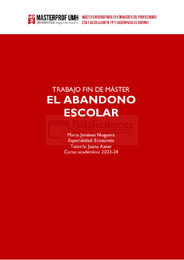Please use this identifier to cite or link to this item:
https://hdl.handle.net/11000/32998Full metadata record
| DC Field | Value | Language |
|---|---|---|
| dc.contributor.advisor | Aznar, Juana | - |
| dc.contributor.author | Jiménez Noguera, Marta | - |
| dc.date.accessioned | 2024-09-06T10:14:01Z | - |
| dc.date.available | 2024-09-06T10:14:01Z | - |
| dc.date.created | 2024-06 | - |
| dc.identifier.uri | https://hdl.handle.net/11000/32998 | - |
| dc.description | Especialidad: Economía | es_ES |
| dc.description.abstract | Este trabajo de fin de máster tiene como objetivo analizar uno de los grandes problemas del sistema educativo actual: el abandono escolar. Trata de estudiar las diferencias entre Comunidades Autónomas, que muestran una gran disparidad norte-sur, aunque también la situación en la que se encuentra España en el contexto internacional, que aún se sitúa por detrás de la media de la Unión Europea y de la OCDE en este indicador. Asimismo, se pretende abordar desde una perspectiva de género, estudiando las diferencias entre hombres y mujeres y las competencias en las que destaca cada uno de estos colectivos. Otra de las características de este fenómeno es la multicausalidad. Por lo tanto, en esta investigación se han tratado de buscar y explicar cuáles son algunos de los factores que inciden en el abandono escolar. Finalmente, esta investigación introduce la diferencia del abandono escolar con el término de fracaso escolar. Debido a la ambigüedad y a veces confusión de estos dos términos, se estudian desde sus diferentes acepciones. Es por ello que este trabajo también incluye un análisis de la tasa de graduados en ESO y la última información disponible del “Programa para la Evaluación Internacional de los Alumnos”, PISA 2022 | es_ES |
| dc.description.abstract | This master's final project aims to analyze one of the major problems of the current education system: school dropout. It tries to study the differences between Autonomous Communities, which show a great north-south disparity, but also the situation in which Spain finds itself in the international context, which is still behind the average of the European Union and the OECD in these indicators. It is also intended to be approached from a gender perspective, studying the differences between men and women and the skills in which each of these groups excels. Another characteristic of this phenomenon is its multi-causality. Therefore, in this research we have tried to find and explain some of the factors that influence school dropout. Finally, this research introduces the difference between school dropout and the term school failure. Due to the ambiguity and sometimes confusion of these two concepts, they are studied from their different meanings. That is why this work also includes an analysis of the ESO graduation rate and the latest information available from the “Program for International Student Assessment”, PISA 2022 | es_ES |
| dc.format | application/pdf | es_ES |
| dc.format.extent | 30 | es_ES |
| dc.language.iso | spa | es_ES |
| dc.publisher | Universidad Miguel Hernández | es_ES |
| dc.rights | info:eu-repo/semantics/openAccess | es_ES |
| dc.rights | Attribution-NonCommercial-NoDerivatives 4.0 Internacional | * |
| dc.rights.uri | http://creativecommons.org/licenses/by-nc-nd/4.0/ | * |
| dc.subject | Abandono escolar | es_ES |
| dc.subject | Fracaso escolar | es_ES |
| dc.subject | Brecha inversa de género | es_ES |
| dc.subject | Gasto en educación | es_ES |
| dc.subject.other | CDU::3 - Ciencias sociales::37 - Educación. Enseñanza. Formación. Tiempo libre | es_ES |
| dc.title | El abandono escolar | es_ES |
| dc.type | info:eu-repo/semantics/masterThesis | es_ES |

View/Open:
TFM Jiménez Noguera, Marta.pdf
750,14 kB
Adobe PDF
Share:
.png)
